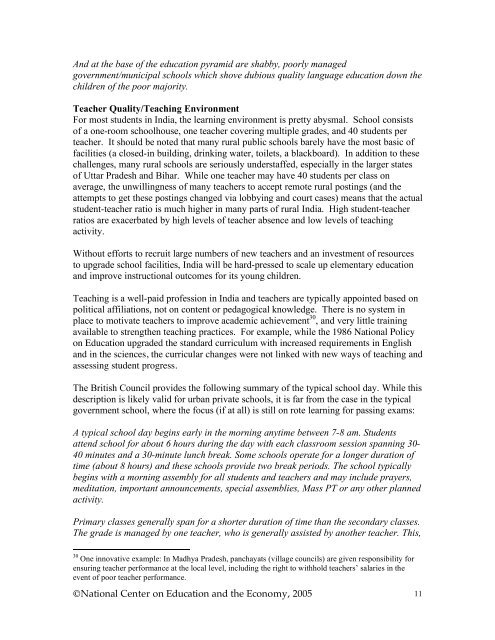India Education Report (2005) - NCEE
India Education Report (2005) - NCEE
India Education Report (2005) - NCEE
Create successful ePaper yourself
Turn your PDF publications into a flip-book with our unique Google optimized e-Paper software.
And at the base of the education pyramid are shabby, poorly managed<br />
government/municipal schools which shove dubious quality language education down the<br />
children of the poor majority.<br />
Teacher Quality/Teaching Environment<br />
For most students in <strong>India</strong>, the learning environment is pretty abysmal. School consists<br />
of a one-room schoolhouse, one teacher covering multiple grades, and 40 students per<br />
teacher. It should be noted that many rural public schools barely have the most basic of<br />
facilities (a closed-in building, drinking water, toilets, a blackboard). In addition to these<br />
challenges, many rural schools are seriously understaffed, especially in the larger states<br />
of Uttar Pradesh and Bihar. While one teacher may have 40 students per class on<br />
average, the unwillingness of many teachers to accept remote rural postings (and the<br />
attempts to get these postings changed via lobbying and court cases) means that the actual<br />
student-teacher ratio is much higher in many parts of rural <strong>India</strong>. High student-teacher<br />
ratios are exacerbated by high levels of teacher absence and low levels of teaching<br />
activity.<br />
Without efforts to recruit large numbers of new teachers and an investment of resources<br />
to upgrade school facilities, <strong>India</strong> will be hard-pressed to scale up elementary education<br />
and improve instructional outcomes for its young children.<br />
Teaching is a well-paid profession in <strong>India</strong> and teachers are typically appointed based on<br />
political affiliations, not on content or pedagogical knowledge. There is no system in<br />
place to motivate teachers to improve academic achievement 30 , and very little training<br />
available to strengthen teaching practices. For example, while the 1986 National Policy<br />
on <strong>Education</strong> upgraded the standard curriculum with increased requirements in English<br />
and in the sciences, the curricular changes were not linked with new ways of teaching and<br />
assessing student progress.<br />
The British Council provides the following summary of the typical school day. While this<br />
description is likely valid for urban private schools, it is far from the case in the typical<br />
government school, where the focus (if at all) is still on rote learning for passing exams:<br />
A typical school day begins early in the morning anytime between 7-8 am. Students<br />
attend school for about 6 hours during the day with each classroom session spanning 30-<br />
40 minutes and a 30-minute lunch break. Some schools operate for a longer duration of<br />
time (about 8 hours) and these schools provide two break periods. The school typically<br />
begins with a morning assembly for all students and teachers and may include prayers,<br />
meditation, important announcements, special assemblies, Mass PT or any other planned<br />
activity.<br />
Primary classes generally span for a shorter duration of time than the secondary classes.<br />
The grade is managed by one teacher, who is generally assisted by another teacher. This,<br />
30 One innovative example: In Madhya Pradesh, panchayats (village councils) are given responsibility for<br />
ensuring teacher performance at the local level, including the right to withhold teachers’ salaries in the<br />
event of poor teacher performance.<br />
©National Center on <strong>Education</strong> and the Economy, <strong>2005</strong> 11


